
By Matthew B. Cox
THE MEXICAN, Juan Medina Gonzales, was on time, as usual. He pulled the mid-sized RV to a stop just shy of the house. Karey hadn’t expected the RV. Typically, Juan dropped off around thirty to forty pounds of marijuana a week–-once he’d fronted him two hundred pounds—always arriving in an aging Toyota Corolla. But Karey wasn’t concerned.

The twenty-four-year-old had only been selling weed for a few months. He mostly sold to friends, and friends of friends. Karey didn’t consider himself a drug dealer. He was a musician—by all accounts a talented one—but the weight had begun to swell. The way Karey saw it, he was just spreading the good times around to “like minded individuals.” It was just a little weed.
The stash house was in the South Florida sticks, a stones throw from the Everglades. The perfect spot for a clandestine drop of mid-grade pot or “mids” straight from Mexico. It wasn’t the ultra-expensive, top shelf hydroponic marijuana; nor was it low-grade cheap “dirt” weed. Mids was a lime green Mexican popcorn, damn near kush quality, and it was juuust right for Florida’s stoner crowd.
Juan was very secretive about his business. Overly serious, thought Karey, bordering on paranoia. The Mexican stepped out of the RV and smiled. He was always very friendly. Karey gleaned a hint of mischief in his eyes and then it was gone. Juan was definitely a drug dealer. Possibly, cartel, but Karey wouldn’t allow himself to think about it.
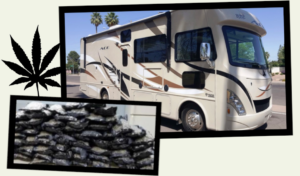
“Come, my friend,” said Juan in broken English. He waved Karey and his buddies, Danny and Keith, over. He and Karey entered the rear of the RV through the narrow side-door. Juan leaned between the front seats and removed the CD’s faceplate in the dash. He pushed a flat-black makeshift button. The distinct sound of hydraulics could be heard coming from underneath the vehicle and a one-foot by one-foot section of the carpet slowly raised up, creating a six inch opening in the floor.
“Cool,” whispered Karey. It was like something out of a James Bond movie.
Juan reached into the breach and grabbed hold of something. Then he tugged a pillow sized twenty-pound bale of pot out of the opening, by a rope. The package was wrapped in clear-cellophane multiple times. Between each layer of plastic the bale had been coated with motor oil to absorb the odor. Still the pungent aroma of freshly harvested marijuana overwhelmed him.
Juan handed Karey the bundle and Karey handed it to Danny, standing outside the door. Danny then handed it to Keith, who toted the bale into the house. Juan continued to pull the rope, which revealed a second pillow full of weed. Then there was a third, fourth and a fifth.
In short order they had formed a human chain. Somewhere around the seventeenth bale Karey got concerned. He’d never taken possession of more than a couple hundred pounds.
“Juan,” Karey said, nervously chuckling, “I, I can’t move this much.”
“No problem,” replied Juan without slowing his pace. He handed Karey the next bundle and said, “Good product. You sell, no problem, my friend.”
Juan didn’t seem like the type of guy you disappointed. By the twentieth bale Danny hissed, “Karey, what’s happening?” He and Keith looked terrified. Neither of them had ever seen more than twenty pounds. “It’s too much. This is too much.”
Karey was baffled. He kept thinking the next one had to be the last, but they kept coming. At one hundred and ten bales, Juan announced, “That’s it my friend.” He exited the rear of the RV, patted Karey on the shoulder, climbed into the driver’s side door and drove off.
Karey shuffled into the living room feeling dazed. The whole scene felt surreal. Danny’s gaze was fixed on the bundles haphazardly strewn around the room; anxiety radiating off him like gaseous vapor. Keith was lying on the couch with his fingers dug into his hair, taking deep gulps of air and mumbling, “I can’t be involved in this. Can’t be involved in this.” He was teetering somewhere between hyperventilating and passing out. “Oh my god” he whimpered,
“I can not be involved in this.”
There were stacks of weed piled up in the corners of the room. Tower after tower along the walls. Cellophane wrapped pillows covered the coffee-tables, the chairs and the ottoman. There were bales everywhere. Everywhere. Twenty-two hundred pounds. A metric ton of marijuana, with a wholesale value of more than three million dollars. Karey could hardly believe it. Oh my god, he thought, I’m a drug dealer.
THE SINALOA CARTEL, known as the “Federation,” was the most powerful drug trafficking syndicate the world has ever seen. The Federation controlled trafficking operations on an international scale, with the majority of its drug distributed in the United States.
By the time Karey had gotten involved in marijuana trafficking, the Sinaloa Federation had come to dominate the marijuana trade. The cartel operated large scale plantations in the Mexican state of Sinaloa and the surrounding “Golden Triangle” area; it had also established control over its territory, which included the American border region stretching from San Diego, California to El Paso, Texas, an area Mexicans call “La Frontera (The Frontier).”
The Sinaloa Federation’s various factions controlled a multibillion-dollar network responsible for smuggling hundreds of tons of marijuana into the U.S. for the cartel every year. Unbeknownst to Karey and his partner, Danny, they were on their way to becoming an intricate piece in that chain.
“I’M NOT EVEN A BIG POT smoker,” Karey tells me during our first interview at the low security prison located within the Coleman Federal Correctional Complex in Central Florida. It’s late February 2017 and the rock star turned drug smuggler is scheduled to be released in November.
Karey was raised in Fort Myers on Florida’s Gulf Coast just north of the Everglades. His parents were ultraliberal ex-hippies, supportive and nurturing. As a kid, marijuana wasn’t discouraged or even frowned upon, still he only smoked occasionally. “Maybe once or twice a month, that’s it.”
“Right, right,” I reply while scribbling out a note. We’re sitting at a fiberglass picnic table underneath an aluminum awning in an area of the recreation center. There are flat-screens mounted on the wall behind us. Donald Trump is our new president and he’s talking about building “The Wall.”
A gaggle of homosexuals and transgenders walk by and girlishly wave at me and Karey. Their hair is braided tight to their scalps in “cornrows,” three of them have boob jobs, one has the full package—silicon breasts, hips and butt implants. All of them are wearing makeup consisting of Kool Aid and M&M’s. They have nicknames like Bro Derek, Tyler Swift, Nick Minaj and Lady Ca Ca.
One of the “girls” winks at Karey, he turns to me and asks, “Does it freak you out a little that there are guys with tits in here?”
“It used to,” I shrug, “but what’re you gonna do?” After ten years inside the Federal Bureau of Prisons, not much shocks me. Karey however, despite his time inside, is still a babe-in-the-woods; oblivious to the gang related prison politics and the potential dangers that lie around every corner.
Unlike the other inmates that populate the prison, Karey shakes people’s hands and smiles constantly. He’s energetic, enthusiastic and upbeat. It’s a little irritating. During our discussions, I’ve noticed he tends to minimize the scale of the smuggling ring that led him to prison. Nothing, however, about the court documents or articles I’ve read indicates Karey and Danny we’re running a small enterprise.
Although the Sinaloa Federation’s operations within the United States do take the form of a supply chain that relies heavily on compartmentalization–-each link in that chain is only aware of their own function and operational aspects—it’s unlikely Karey was unaware of the cartel’s involvement.
“So,” I say, “tell me about Juan.” Karey smiles and tells me that Juan was a “real nice guy.” In fact, Juan “Kapechi” Medina was the organizer and leader of the Medina Drug Trafficking Organization, an operation responsible for the distribution of tons of marijuana every month; product being smuggled through the Arizona/Sonora border by Joaquin “El Chapo” Guzman’s faction of the Sinaloa Cartel directly to Medina’s organization. The marijuana was then transported to Medina’s wholesale customers in Nevada, Iowa, Virginia, and throughout the southern states, one of whom was a certain struggling musician living in South Florida.
“Bro,” gasps Karey, “I swear, I had no idea Juan was a cartel member.”
KAREY LEE WOOLSEY spent most of his preteen-years grounded. He was a hyper kid, always misbehaving at school—talking in class and spitting spit-balls—that is, when he went to school. He skipped quite a bit to hangout at different girls’ houses.
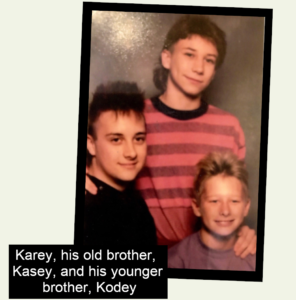
His love of music started with his father’s garage band. By age twelve, the music-bug had dug its teeth in deep. Karey would walk around the house playing the air-guitar and singing We’re Not Gonna Take It by Twisted Sister. His mother, Linda, gave her budding rock star a Yamaha guitar and told him to give the real thing a try. “I thought it would give him something to do,” she says, “while grounded. He was always grounded.”
Karey locked himself in his room, watched some videos, read a couple of books and taught himself to play. Like most natural talents, music came easy to him.
His mother recalls hearing the Black Crows’ She Talks to Angels, emanating from her son’s room. Irritated, she barged in prepared to chastise him for playing his stereo too loud. She was shocked to find Karey strumming his guitar and singing in perfect pitch. “It was the most beautiful thing I’d ever heard.”
Shortly thereafter, Karey began penning his own songs. Original compositions heavily influenced by popular eighties hair-bands like Def Leopard, Skid Row and Poison. Within months of picking up a guitar he’d formed Sweet Madhouse with a group of friends.
They practiced and practiced, until Karey felt they were ready for their first gig. He convinced his parents to rent out Fireman’s Hall in Coral Springs, Florida. They passed out fliers and made phone calls—tickets ran $2, and for fifty cents extra you got a soda.
Just before Karey’s fourteenth birthday, Sweet Madhouse took the stage to a crowd of over five hundred screaming teens. He could hardly believe the turn out. The place was packed.
“Halfway through their set some girl threw her panties at my son,” says Linda. “Her panties,” she repeats with an audible sigh. “I remember thinking, ‘My God, what’s he gotten himself into?’ After that, there was no stopping him.”
Karey’s father, Popa, acted as the the band’s manager; booking them at local clubs for teen nights. Karey and the band—now calling themselves Smut—jammed to their peers. They played weddings and just about every school function: Homecoming, Sadie Hawkins, Prom, etc.
“After a gig—like an extraordinary gig,” says Karey, “me and the Smut boys would sit around, get high and dream about becoming rock stars; ya know, sex, drugs and rock-n-roll.”
MAYO HAD A PROBLEM. By the turn of the century, Ismael “El Mayo” (pronounced My-ō) Zambada was the head of the Sinaloa Cartel. This was before the drug trafficking syndicate had achieved international notoriety. Back then, it was merely one of a handful of regional cartels operating out of western Mexico.
The Sinaloa Cartel was embroiled in full blown gang warfare; simultaneously fighting the Tijuana Cartel from the north and its more powerful ally, the Gulf Cartel in the east. While each of the west coast cartels operated independently, they all struggled with the same problem: the rise of the Gulf Cartel.
The Gulf Cartel had established itself as the dominant drug trafficking syndicate in North America during the late 1990s. A criminal syndicate which operated out of northeastern Mexico under the leadership of Osiel Cardenas, the cartel was encroaching on territory controlled by Mayo and the other Pacific coast kingpins.
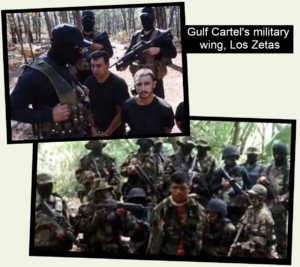
The source of the Gulf Cartel’s power was a weapon unparalleled in the history of organized crime. Under the direction of Cardenas, the cartel formed a paramilitary unit known as Los Zetas. Initially, comprised of thirty-one corrupt Mexican soldiers that had been trained in the United States by the American military’s Special Forces and Navy Seals. These elite commandos had been persuaded to defect from the Mexican Army. Within short order, the unit had swelled to three hundred highly trained killers.
Unlike the undisciplined thugs the Pacific coast cartels were using for muscle, the Zetas were a disciplined military force that utilized modern military tactics against their rivals.
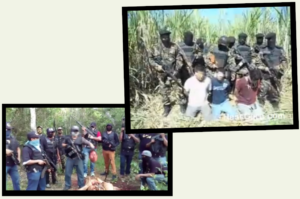
This is what kept Mayo up at night. He and the other drug lords helplessly watched, panic-stricken, as the Zetas expanded the Gulf Cartel’s sphere of influence with military precision. The Sinaloa Cartel was losing ground fast. Drastic action was necessary before they were all swept under the control of their Gulf Cartel rivals.

He and the band had spent the last five years playing bars and clubs up and down the west coast of Florida. They’d performed at virtually every college campus from the University of Miami in South Florida to Valdosta State University in Georgia. Karey and the guys had opened for Del Amitri and Sister Hazel; and even toured with Creed—before Creed was Creed—for over a year and a half.
Karey and the band had been checked out by lots of artist recruiters. There had been meetings with major record label executives and talk of record deals, but none of them materialized. His career wasn’t going anywhere. He was twenty-three-years-old, tired and struggling financially.
Once the band’s set ended, he caught up with the hot chick. She was with a group of friends; one of them was a guy named Jason. He told Karey, if he needed any weed to let him know, “I’ve got a’ plug straight outta Mexico.”
Karey wasn’t all that interested, but he knew his quasi-adopted-brother, Danny, would be. Daniel Sweep and Karey had been friends since their early teens. Due to family issues in the Sweep household, Karey’s parents had practically raised Danny as one of their own. He was selling dime bags of weed out of his apartment, not a lot of pot, maybe a pound a month. So Karey connected Jason with Danny and a week later he was holding twenty pounds of high-grade, lime green Mexican popcorn. More than he’d expected.
Danny asked Karey to help him sell it. Karey made a few calls to a couple of musician buddies and it was gone. It was easy. Very, very, easy. Word got around that Karey had “the hook-up” and his cell started ringing. Karey bought twenty pounds a week later, which he quickly sold.
Days after that, Jason dropped off another twenty pounds, which Karey quickly moved. Then Jason fronted Karey forty pounds and two weeks later another forty pounds.
By this point, Jason had gotten himself arrested. He was hooked on oxycodone and in a real jam. Karey agreed to get him out of jail and into a rehab on one condition, Jason had to introduce Karey to his plug, a Mexican named Juan.
DEEP IN THE SIERRA MADRE mountains in Sinaloa, Mexico, while the other west coast kingpins were gripped by paralyzing fear, Mayo formulated a plan—audacious in its scope, yet brilliant in its simplicity. To execute his plan, however, he would need the assistance of his paisan, Joaquin “El Chapo” Guzman whom, along with Mayo, were the founders of the Sinaloa Cartel. Unfortunately, Chapo was serving a twenty year sentence in a Mexican prison for drug trafficking and murder.
On January 19, 2001, Mayo arranged to have Chapo escape from prison by several guards. Once outside of the facility’s walls, Chapo was smuggled out and whisked away by a helicopter.
With Chapo’s help, Mayo was able to persuade Ignacio “El Nacho” Coronel Villareal, the leader of the cartel controlling the Mexican state of Jalisco. No one knows precisely when the conference occurred, however, at that meeting in the city of Guadalajara, Mayo and Chapo convinced Nacho to help them create a federation from among the Pacific coast cartels—a super-cartel. Mayo’s plan was to create a drug trafficking behemoth strong enough to mount a united front against the Tijuana and Gulf cartels. Nacho agreed and shortly thereafter, the Federation was born.
In short order, Mayo, Chapo and Nacho met with Arturo Beltran-Leyva, a kingpin who controlled his own organization in Sinaloa. Together they entered into a strategic alliance with Vicente Carrillo Fuentes, the leader of the Juarez Cartel in Chihuahua. Then, the leaders of the Sonora, Durango, Colima and Michoacan cartels all agreed to Mayo’s plan. Much like the superheroes that came together to form The Avengers, a group of the most powerful west coast kingpins had joined forces to create what became known formally as “el Cartel del Pacifico (the Pacific Cartel) ” or, less formally, the “Sinaloa Federation.”

The Federation operated on a horizontal leadership structure. The cartel’s operatives each controlled certain territories, making up a decentralized network of bosses who conducted business through alliances. Together, under the leadership of Mayo and Chapo, the cartel launched offensives against the Tijuana and Gulf cartels.
By the time Karey had become established in the marijuana trade, the Sinaloa Federation had eliminated all competition along the border from San Diego, California to El Paso, Texas. Seventeen ports of entry were now firmly under their control. Each of the Federation’s major factions worked with one another to smuggle marijuana into the United States, where American-based organizations then distributed the product throughout the country. One of these organizations was a large distribution cell in Tucson, Arizona led by Juan Medina.
According to Karey, Juan was very personable—polite and business-like. He stopped by Karey’s apartment shortly after they’d been introduced, ostensibly, to drop off fifty pounds of popcorn weed. “He looked around my place, we talked about my mom and dad… Real nice guy.”
What Karey didn’t understand was that, despite the majority of the cartel’s operations being decentralized, their internal hierarchy is very much a family business. Fathers, brothers, sons, nephews and in-laws occupy the top positions in most of the organizations. As insurance, everyone holding a key position know their associates’ families and, more importantly, where their mothers live. With that said, the potential for murderous reprisals trickles down the chain.
Juan asked if Karey’s family lived in Fort Myers and inquired about his credit rating, which struck the musician as comical. Then, he gave Karey two hundred pounds of mids—one hundred and fifty pounds more than Karey had expected. More than Karey and Danny could sell to their stoner buddies. The smell alone was reason enough to motivate Karey to move the product quickly, he tells me. His entire place reeked of marijuana.
Fortunately, the word was out, and the local dealers were eager to buy up all the marijuana Karey and Danny could get their hands on. It was gone in less than a week.
Days later Juan showed up with the RV and a metric ton of mids. There was no denying it after that; Karey Woolsey was a drug dealer. Within three weeks he and Danny had gotten rid of every single bud and they were sitting on nearly a million dollars. Things only escalated from there.
Despite the illegality, like everything Karey does, he put everything he had into the new venture. He arranged for a remote stash house, code words and prearranged drops. He quickly put together a network of local dealers throughout South Florida. For his part, Juan set up a second stash house, stocked with several tons of weed near Karey’s place. In short order, Juan’s cousin, Miguel, was swapping out bags of cash for bales of fresh bud, weekly.
“YOU HAVE TO UNDERSTAND,” says Danny during one of our interviews, “Karey acts like he stumbled into the marijuana business, but he created it.”
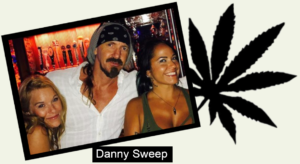
In my attempt to obtain an accurate account of the story, I spoke with and emailed Danny dozens of times. He was on home confinement and wearing an ankle monitor, after being released from prison in October 2016. Despite his hippie-like appearance, “stoner” doesn’t adequately describe Danny’s character. In fact, Juan and his associates nicknamed him “Buki,” because he resembled the long-haired Mexican musician, Marco Antonio Solis, known as “El Buki,” who sings soft love ballads. However, Danny has more of an edgy, hipster-thing going on than a Bohemian flower child.
Although Danny continually told me he didn’t want to say anything disparaging about Karey, he did describe his co-defendant as a “serious” and, “when necessary, a ruthless business man. Karey’s the boy next door, prom king, band dude,” he tells me. “He makes you believe in him and he takes you for a ride. His personality is the real story. Seriously, how does a prom king become a drug dealer?”
Despite Karey’s “intensity” and “drive,” Danny says when Juan asked them if they’d be willing to distribute cocaine—a much more lucrative product—Karey flatly refused. “He thought of weed as a soft-core-drug, harmless.”
THE SINALOA FEDERATION’S creation had hindered the spread of the Gulf Cartel, but it hadn’t stopped it. The Gulf Cartel was continuing to seize territory through the Zetas’ military style campaign of murder and intimidation. Mayo’s plan had merely postponed the inevitable.
He formed the cartel’s own enforcement wing dubbed “Los Mata Zeta (the Zeta Killers). ” Led by Chapo, they were tasked with eliminating each and every Z-member present in their territory. Through torture, beheadings and public hangings off of freeway overpasses throughout the Federation’s controlled territory, the Mata Zetas waged war against the commandos with no discernible impact on the Gulf Cartel’s overall expansion.
The Federation was losing the “narco trafficking war” to a superior military force and despite their efforts, Osiel Cardenas and the Gulf Cartel seemed unstoppable.
Fueled by desperation, Mayo contemplated a second alliance. He directed his trusted consigliere, Humberto Loya-Castro, to contact the United States government. Loya, himself an American attorney and a member of the California bar, was wanted by the U.S. authorities after being indicted in San Diego along with Chapo Guzman a few years earlier. The indictment alleged that Loya had been laundering drug money and bribing officials, charges which he had been dodging for some time.
Precisely where and when the clandestine meeting took place is unknown. However, according to multiple federal court documents—motions, transcripts, affidavits, etc.—the events played out in the following manner; at the aforementioned meeting Loya struck a deal with the U.S. government. An agreement that was approved at the highest level of the U.S. Attorney’s Office and the Drug Enforcement Administration in Washington, D.C.
In exchange for providing the Americans with information about the Sinaloa Federation’s rivals, the United States agreed not to interfere with the Federation’s drug trafficking operations. In addition, the U.S. Attorney’s Office agreed to drop the indictment against Loya upon the completion of his cooperation and agreed not to prosecute the Sinaloa Cartel leadership which, everyone understood to include, Mayo Zambada and Chapo Guzman.
Although the U.S. Attorney’s Office resisted, eventually, Loya was provided a formal document acknowledging the existence of their agreement.
In essence, the U.S. government entered into an alliance with one of the largest, most violent, criminal organizations in the world—run by two of the most wanted men on the planet—an alliance which afforded the Sinaloa Cartel carte blanche to smuggle hundreds of tons of illicit drugs into the United States in exchange for providing the Americans with the information needed to wipe out the cartel’s rivals. Not a bad deal for Mayo and the boys…
DRUGS AND ROCK-N-ROLL have always been a part of Danny’s life. Prior to joining Karey’s conspiracy, he was booking bands and managing bars in the downtown Fort Myers’ club scene. Danny was the “go to guy” for visiting rockers, providing a “safe place to chill” while they were in town.
“I’ve hung-out with Eddie Vedder (from Pearl Jam), and done blow with Mark Chavez, the lead singer of Adema,” says Danny. Once, in early 2002, Jerry Cantrel of Alice In Chains knocked on Danny’s door. “We partied all night; my girlfriend had written a’ message to me on the bathroom mirror in lipstick, ‘You’re so cool.’ It’s a line from the movie, True Romance. 1 I remember Jerry commented, ‘Great movie.’ Bro, it’s like I’ve always been a part of that scene, always and forever.”
1 The 1993 film, True Romance, brings together the cast of Christian Slater, Patricia Arquette, Dennis Hopper, Christopher Walken, Samuel Jackson and Brad Pitt. The unlikely ensemble mixes horrific violence with dark humor in this pulp fiction, action thriller cult classic.
NOTWITHSTANDING LOYA’S status as a wanted fugitive—by both the U.S. and Mexican authorities—the Sinaloa Federation’s consigliere began attending monthly meetings with the DEA on both sides of the border. 2
2 Based on court documents Loya’s DEA handler was Special Agent Manuel “Manny” Castanon. However, when exactly Agent Castanon became Loya’s handler is under dispute.
It was at these meetings that Loya, using information provided by Mayo and Chapo, was able to manipulate their newest ally into surgically wiping out the Federation’s competition. The information flowed through the DEA to the Mexican military and the results were unmistakable.
On February 10, 2002, the Mexican Federal Police made its move to arrest Ramon Arellano-Felix in Mazatlan, Sinaloa—the second-in-command of the Tijuana Cartel. While attempting to evade capture, he was gunned down by the federales. Less than a month later, in the state of Puebla, Ramon’s brother, Benjamin Arellano-Felix, the leader of the Tijuana Cartel, was arrested by the Mexican army. (He was later extradited to the U.S. and sentenced to 25 years on racketeering and money laundering charges.) The swift elimination of the Tijuana Cartel’s leadership crippled the organization.
Over the next several months, dozens of lower-level members of the Federation’s rivals were picked off by the Mexican military in various raids throughout the country. Then, on March 14, 2003, the Mexican army captured the head of the Gulf Cartel, Osiel Cardenas, following a shootout in Matamoros, Tamaulipas.
Mayo and Chapo, in a little over a year had engineered the decapitation of both the Tijuana and Gulf cartels. In the ensuing chaos, the Sinaloa Federation went on the offensive and began to seize control of their rivals’ territory. Nowhere was their success more evident than in Baja California. With two of the Arrellano-Felix brothers out of the way, Mayo’s organization rose to challenge their organization for control of the Tijuana plaza. Mayo’s top lieutenant (and brother-in-law) German Olivares was responsible for overseeing the lucrative Tijuana-San Diego corridor for the Sinaloa Cartel, and for ordering countless murders during the Federation’s brutal war for control of Tijuana.
With the help of their American allies and the Mexican military, the Sinaloa Federation ascended to primacy among the Mexican cartels and was now the dominant drug trafficking syndicate in the Western Hemisphere. The floodgates were opened.
KAREY LIKED THE BLACK BMW X5 better than his Porsche 911. People were always staring at him when he drove the Porsche. It was a sparkly, metallic silver and very flashy. The last thing he wanted was attention.
The pot business had been running hiccup-free for over three years. Karey had the posh house with the big pool, the classic ’67 Mustang he’d always wanted and a couple of luxury sports utility vehicles. The gorgeous girlfriend, Rachel Telfor, a licensed Florida real estate agent with bottle-blonde hair and Betty Boop curves. They vacationed in Cancun, Mexico; Nassau, Bahamas and Costa Rica.
There wasn’t a rock concert in South Florida he didn’t attend. Karey was still playing gigs on some weekends, not so much for the money, but because he loved it. Music was his life.
The profits from the marijuana operation were unreal and easily laundered. Using a combination of rental properties and flipping houses, Karey’s illicit funds were washed clean of their origins. Everything had been going very smooth.
“That’s when Juan’s guys started gettin’ busted—in early 2004—one after another,” says Danny. Karey got a little worried. It was either dumb luck or there was a leak in Juan Medina’s organization. Either way, “the town was dry” and Karey was desperate for product. That’s when he decided Danny should take responsibility for the transportation. Karey negotiated a better price and coordinated the clandestine “meets.” Danny, however, was in charge of transporting the loads. “I dropped off two hundred thousand [dollars]—money Karey owed Juan—in Tucson, Arizona.”
Danny rented a room at a local hotel, parked his rental in the rear of the building’s parking lot and went to his suite. He left the key in the ignition, and the cash in a suitcase, sitting in the passenger seat. One of Juan’s guys picked up the rental and returned it approximately two hours later. “The money was gone and there was three hundred pounds of weed packed into the trunk,” recalls Danny. “I never saw anyone.”
They began recruiting friends, and friends of friends, to drive bales of bud from Arizona to Florida. Drivers were paid $10,000 per load, and there were no shortage of south Floridians willing to take the risk.

Every other month, however, Danny specifically transported the millions of dollars necessary to keep the product flowing.
Mayo had played the U.S. government perfectly. The scheme had worked so well in fact that Chapo had gotten greedy. He decided they were now in a position to betray the other members of the Federation in order to take over their territories. Chapo had arranged a secret conference in Monterrey, Mexico, with Mayo, Arturo Beltran-Leyva and a disgruntled member of their first victim, Juan Jose “El Azul” Esparragoz-Moreno, the second in command of the Juarez Cartel.
During that meeting, the three Sinaloa Federation members, and Azul, discussed when and where to murder his boss.
When Carrillo-Fuentes and his family exited the mall, Chapo’s hit squad opened fire. The cartel head and his wife were pelted with automatic fire. They died on the pavement in the plaza.
As Mayo and Chapo tried to seize control of the Juarez-El Paso corridor, the City of Juarez erupted into violence. Suddenly they were on the front lines of the drug war. Seemingly overnight, Chapo’s single act of betrayal, turned Juarez into the murder capital of the world which, in turn, prompted the Americans to double down on their efforts to eliminate Mayo’s enemies.
The double-cross sparked the collapse of the Federation’s security pact with the Juarez Cartel, and once again, the core factions of the Sinaloa Cartel were fighting a war on multiple fronts. This time, however, Mayo had a powerful ally, Uncle Sam.
DANNY’S GUY was minding his own business pumping unleaded into his sedan when the Arizona Highway Patrol cruiser pulled up beside him. It was around noon, November 3, 2004, somewhere in Navajo County, just east of the Interstate 40 and 17 junction in Flagstaff—a common route used by traffickers transporting product throughout the country. It might have been the vehicle’s Florida tag or the driver’s long stringy hair, but something about him didn’t look right to the trooper. He damn sure wasn’t from Arizona. Before the driver could exit the gas station’s lot, a K-9 Unit pulled to a stop in front of his vehicle.
Danny called the driver’s “burner” prepaid cell phone shortly after the troopers searched the vehicle. “Hello Danny,” said an official voice—the driver had programmed Danny’s first name into his cell. Still, it sent a shock through Danny to hear his name. “We’ve got your dope, motherfucker, and we’re coming for you!”
Danny hung-up and tossed his burner in the trash. Frantically, he dialed Karey’s number. “What do I do? They’ve got our guy!”
They had discussed the scenario many times among each other, and with the drivers. If anyone were to ever get caught, anyone, Karey and Danny were responsible for their legal fees. Nothing more. “Get ‘im a lawyer,” replied Karey, “and walk away. He knew the risks.”
Danny did precisely as Karey had instructed, however, it bothered him. Not wiring the driver’s attorney $15,000, but the walking away part. If anyone gets busted, anyone, Karey said many times, you walk away. No exceptions.
KAREY AND DANNY didn’t know Miguel had a serious alcohol induced domestic violence problem. Sometime in mid 2005, he went on a drunken bender and began slapping his girlfriend around. This time, however, she’d had enough. When Miguel’s head was turned she stabbed him in the back with a kitchen knife. He stumbled out of Juan’s stash house and collapsed in the front yard with the knife sticking out of his back. One of the neighbors called 911.
When Fort Myers Police officers arrived, they immediately placed the Hispanic female under arrest. During a search of the residence the officers discovered approximately one hundred and eighty pounds of mid-grade Mexican popcorn, half a million dollars in cash and several drug ledgers. Scribbled on nearly every page was the alias “Musico.” That was the name Juan and his cousin had dubbed Karey with, an alias that Karey had embraced.
The investigation was handed over to the DEA and they begin to make inquiries. Shortly after the bust, Juan stopped answering his phone. Subsequently, his number was disconnected and the town went dry.
After a couple of months of listening to his dealers begging him for bud, Karey hopped on the Internet. A quick search revealed a significant amount of marijuana was being imported into the United States through San Diego in Southern California.
The San Diego-Tijuana corridor was under the control of German “El Paisa” Olivares—Mayo’s top lieutenant—known simply as “G” to his American drug trafficking associates. G’s network was responsible for smuggling marijuana into the United States to the cartel’s distributors. He’s been described by Justice Department officials as a “shadowy underworld figure,” a member of the Sinaloa Federation’s “upper echelon” who had ordered countless murders.
Karey arrived at the Catamaran Hotel & Spa on Mission Beach, north of downtown San Diego, around 7:00 p.m. He immediately called an escort service, not for sex, but because Karey knew the girl would know the local drug scene. For two hundred bucks, the sexy little thing who showed up at his suite took Karey to a highbrow hookah bar where the local players hung-out. She introduced him to a guy that hooked Karey up with a plug—one of G’s distributors—named Arturo Eliseo Martinez-Barrera, whom everyone called by his nickname “Apples.”
“Two days after leaving the airport, I was talking to Apples,” Karey tells me. “He had guys bringing over stuff from Mexico, through the Tijuana port of entry.” Karey, in all sincerity, describes Apples as a real nice guy. And he couldn’t beat the price either. For five hundred bucks a pound, Apples assured him he could provide Karey with as much mid-grade herb as he could handle. The only problem was Karey—which meant Danny—had to transport the product. “At the time, I didn’t know Apples was working with the cartel, but, you know, he did seem kind of cartel-ish.”
Karey had Danny and Rachel (Karey’s girlfriend) purchase one hundred-grand worth of money orders—the amounts ranged from five hundred to a thousand dollars. It took them the better part of a day.

During our interview Rachel tells me, by this point in their relationship, she knew Karey was selling weed. “I was extremely naive,” she says; and she feels she’d been somewhat “brainwashed” by Karey’s charm. “I didn’t think it was a big deal nor did I have any idea on what level it was taking place.”
The FedEx parcel—containing one hundred and fifty money orders from MoneyGram and Western Union, among other providers—arrived the following morning.
Karey convinced a friend of a buddy’s to drive two hundred pounds of bud from Southern California to South Florida. Apples’ guys loaded Karey’s guy’s old Chevy with several bales of marijuana and, a few days later, Karey and Danny were back in business.
Weeks later he arranged for a second load and then a third. Within a month, Karey was smuggling roughly a ton of marijuana into the Sunshine State every month.
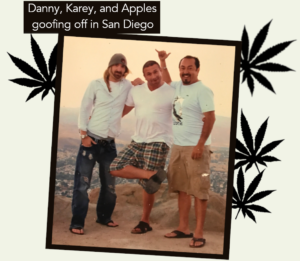
Before long, Karey and Danny were flying out to Southern California a couple of times per month. They’d coordinate the loads with Apples, and afterwards they’d spend a few days partying. Sometimes they’d pickup two or three strippers from Pure Platinum and go out clubbing in the Gas Lamp District in San Diego. Or the Floridians would drive up to LA and get hammered at the Viper Room; pull a couple strippers out of the Seventh Veil; and go listen to some bands rock at the Whisky-a-Go Go on the Sunset Strip.
Danny would then fly back to Fort Myers, unload the bales of herb at the stash house and distribute them to their chain of dealers throughout South Florida.
Danny went with a classic “decoy strategy,” whereby transporters use a “decoy vehicle” to spot law enforcement and act as a diversion for the “chase car” transporting the actual marijuana.
On May 20, 2005, during one of the runs, the guy driving the decoy vehicle, Anthony Keane, got pulled over by the Highway Patrol in Parachute, Colorado, just east of the Utah boarder. The trooper’s dog signaled there were drugs in the car, however, a search of the vehicle at the local Highway Patrol’s Office revealed nothing. The trooper—realizing he’d pulled over a decoy—surreptitiously popped a GPS device underneath the decoy’s rear wheel-well and let the driver go.
Despite Danny telling Anthony not to rendezvous with the driver of the chase vehicle, he met with the other driver at a motel a few miles from the Highway Patrol’s Office. Within minutes the parking lot was crawling with law enforcement.
Karey was at San Diego’s international airport waiting to board a return flight to Florida when his cell rang. Thrifty Car Rental wanted to notify him that his rental had been seized by the DEA.
“What?!” Karey exclaimed, feigning confusion. “That’s crazy; why would they do that?”
The employee from Thrifty sighed. He’d heard it all before. “It was the DEA, so I’m gonna go out on a limb here and say it had something to do with drugs.”
Eighty thousand dollars in weed—with a street value of two hundred grand—was seized. Danny hired an attorney for the drivers, but he and Karey didn’t slow down. Danny simply recruited more guys and loaded up some more rentals.
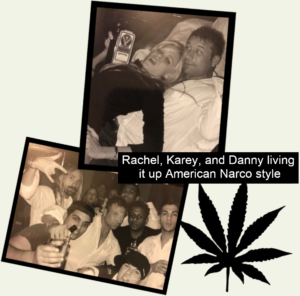
During the subsequent investigation, the names Danny and Musico came up, however, the DEA was never able to put a case together against them.
KAREY FELT SLEEPY and slightly dizzy, but that was about it. His extra-potent marijuana brownie party had been a bust. None of his buddies had gotten high.
He’d pulled the recipe off the Internet; admittedly, Karey had added more pot than the directions called for—he wanted them to be extra-potent—and he let the butter simmer a little too long. In spite of this, Karey felt the brownies should have given them more than a fleeting sugar-high and drowsiness.
He woke up on the couch around 2:00 a.m. and Karey could’ve sworn he was inside a Sponge Bob Square Pants cartoon. He was leaking so much perspiration, he thought he was melting. Karey’s heart was thumping so hard he was certain it was going to burst out of his chest, like when Roger Rabbit saw Jessica Rabbit for the first time. 3
3 Who Framed Roger Rabbit was an eye popping combination cartoon and action movie released in 1988.
Karey’s pet octopus, Mr. Squiggles, was staring at him from his wall sized, one hundred and fifty gallon aquarium. He ran one of his long tentacles across his throat, signifying death, and the room began to spin. Karey knew he was dying. Mr. Squiggles wouldn’t steer him wrong. He knew things.
Karey grabbed the phone and punched in his father’s number, woke him up and gasped, “Popa, something’s wrong with my heart.” He told his father about the extra-potent marijuana brownies. “I poisoned myself, you gotta come get me; take me to the hospital.”
“Karey, dude,” chuckled his father, “calm down; you can’t die from bad pot brownies.”
Several of Karey’s buddies had stayed over—too sleepy to drive—and they were now lying on the floor, laughing uncontrollably at Karey. “I poisoned all my friends, Popa!” cried Karey, ignoring his father. “We’re all gonna die. What’ve I done?!”
“No one’s dying.”
“Oh god, Popa, I’m gonna miss you so much.” Karey begins to sob. His father insisted Karey was having a bad trip, but Mr. Squiggles had been watching from his tank and he looked sad. He looked concerned. He knew Karey was about to die. “Promise me you’ll take care of Mr. Squiggles; he’s a good octopus, Popa. I love ‘im so much.”
“No one’s gonna die,” sighed his father. “You’re just really, really stoned, dude.”
ON THE OTHER SIDE of the border, as the drug war raged on, Loya continued to meet with his DEA handler and other Department of Justice officials. Using information provided by Mayo and Chapo, the U.S. government coordinated multiple raids, directing the Mexican military’s efforts; and the Sinaloa Cartel’s rivals continued to suffer losses. One after another, the Tijuana, Gulf and Juarez cartels’ operations were disrupted and their leadership captured or killed.
The U.S. government was so enmeshed in its relationship with the Sinaloa Cartel, that on several occasions the Americans alerted Loya of apprehension operations being conducted by the Mexican military. Raids being conducted in territories where the cartel’s leadership was believed to be hiding. Essentially, the U.S. government was tipping off Mayo and Chapo to evade capture, so as to protect the relationship.
Meanwhile, in Baja California—with the help of the Mexican military—G was squeezing out the Tijuana Cartel and taking over their drug smuggling routes. Control of the Tijuana plaza flipped over to Mayo, with G being responsible for coordinating the Sinaloa Cartel’s narcotics trafficking activity through the Tijuana-San Diego corridor, including the importation of multi-ton shipments of marijuana into the United States.
With Karey and Danny’s trafficking operation running trouble free, G contacted Apples and “requested” an introduction. He wanted to talk with the American narco that was moving so much of his product.
They met at a market in La Jolla, California, north of San Diego. G’s body guards—a couple of hard looking Mexican thugs—arrived first, driving what Danny described as a “super badass” black, Harley Davidson, limited edition, Ford crew cab dually. G pulled into the parking lot less than a minute later in a caramel Bentley.
Danny waited in the driver’s seat of his Toyota Sequoia SUV—staring at the Mexicans in the truck—while Karey, Apples and G spoke inside the cartel leader’s vehicle.
He was an older, thin Mexican with a head full of hair. G wanted to know how much product they could handle. Karey knew this was an opportunity to expand the South Florida operation throughout the state. “We could do another thousand pounds a month,” said Karey, “maybe another ton.”
G pinched his chin, pensively and contemplated the amount. “You know the Mexican saying ‘plata o plomo (silver or the lead)’?” he asked with a Spanish accent. Nervously, Apples’ eyes darted between the two men. Karey nodded his understanding and G continued, “I have a man at the border, a border patrol agent; this man, we have an understanding.” He then asked how long it would take for Karey and Danny to move twenty tons of marijuana.
“Jesus, twenty tons?”
The plan required them to open a concrete company and purchase two cement mixers in San Diego. The cartel, with the help of the agent, would then use the trucks to smuggle the marijuana across the border. They would then be placed on flatbeds and transported to South Florida.
“It was a twenty ton deal,” says Karey, “they had it all arranged, the border agent, everything.”
In the midst of Karey and Danny incorporating the cement company, leasing a warehouse and looking for the mixers, Juan Medina called—he’d been missing in action for over a year and he was back. He had vehicles loaded with product en route to Florida and he wanted to rekindle their business relationship.
The Floridians were spending more and more time in San Diego—they’d grown tired of blowing a grand a night on hotel rooms—so they purchased a place in La Jolla. The condo was right on the beach and reasonably priced at roughly half a million dollars. The porn star Jenna Jameson and a few other B-actors lived in the building.
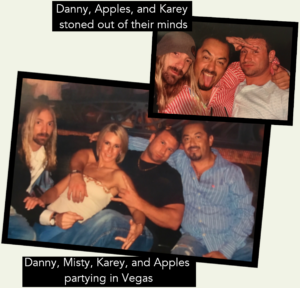
While South Florida was home, Karey loved Southern California. He enjoyed the anonymity and, especially, the beautiful women. According to Danny, Karey had quite an effect on women. It wasn’t uncommon for him to go out drinking and pull a couple of bombshells; take them back to his place in La Jolla; and spend the night rocking their worlds while the girls were flying on Ecstasy. By all outward appearances, Karey was a rock star.
THE PLACE WAS BOOMING from the Banda. Apples took Karey to a nouveau riche Mexican club in downtown Chula Vista. Four hundred half drunk palatosos in cowboy hats and boots; and guapa chiquitas with silky black hair and deeply bronzed skin that Karey’s girlfriend, Rachel, back in Fort Myers, would have killed for.

Halfway through their third round of tequila shots, Apple whispered something in the band leaders ear. “I told ‘im you’re a rock-n-roller,” shouted Apples when he got back to the table. “They want you to sing. Sing white boy, sing!”
Karey doubted the band knew any rock. Out of professional courtesy, he told the band leader he appreciated the offer, but “I don’t know any Spanish songs.”
“You know Scorpions?” he replied in broken English. Karey couldn’t help but grin. “We can play Still Loving You. You know this song?”
“Of course, but…” Suddenly it occurred to Karey that singing in a Mexican club may very well be one of the cooler things he’d do in his life.
Thirty seconds later, the lights dimmed and the electric guitar’s power cords rhythmically growled. The crowd went silent, turned toward the stage and glared in irritated confusion. Karey’s heart almost stopped. Then, the lights surged slightly and the strobes flickered. Karey stepped forward, belted out, Time, it needs time, to win back your love again, and the crowd slowly surged toward the stage.

The men’s weather-beaten brows and the gorgeous mamasitas doll-like eyes gazed at the gringo. According to Karey, at “fight, baby fight, win back your love again” you could hear the building settling; and when he closed out the song with I’m still loving youuu, goose-bumps rippled across the arms of every last soul and the place erupted into a roar.
After seeing Karey perform, later that night, Apples asked him why he was selling drugs when he could sing like that?
“I didn’t have a good answer then,” Karey tells me, “and to this day, I don’t have one.” His eyes well up and the words seem to catch in his throat. “I wanted so bad to be a famous rock star, ya know, when I should’ve been satisfied with being a talented musician.”
APPLES STOPPED at the San Ysidro Port of Entry. He couldn’t go into Mexico, he was illegally in the U.S. Still, it made Danny nervous leaving Apples behind. Karey had been summoned by G to Tijuana and he was more than a little concerned about it.
“I wasn’t about to meet with a fuckin’ cartel member in Mexico,” says Karey. They were buying product from the Sinaloa Cartel through two different plugs and neither Karey or Danny knew what the rules were. They were out of their element in very dangerous territory. “Danny said he’d go. He didn’t see an issue with it at all. He’s crazy fearless like that.”
On the Mexican side of the border, G’s special edition Ford was waiting at the curb. Black with dark tinted windows. The capo smiled warmly at Danny and waved him in.
Danny was driven thirty minutes outside of Tijuana to a complex of desolate warehouses. Nothing but dense sand and tumble weeds. Armed guards walked the perimeter. Hardened men with black mustaches and rudimentary prison tattoos.
Inside, there were a dozen Mexicans stripping down multiple vehicles and re-assembling others. Danny estimated there was approximately thirty tons of marijuana in that one warehouse alone. The costals were stacked from floor to ceiling; more than half the warehouse was occupied by hundreds upon hundreds of bales.
He and the older Mexican sat in a makeshift office. “You move mucho product,” he said, “and you always pay. This is good. This is why we trust you. You always pay.” G’s face became tense and he told Danny he’d once dealt with a man from South Florida. A man that didn’t pay. “I had to send my people to this man’s house. I had to hurt this man. You understand?”
“I understand,” said Danny; and he started to wonder why he’d been brought out to the middle of nowhere. “Always pay. Understood.”
“Good.”
Karey and Danny had set up the bogus concrete company and warehouse back in Florida. It was packed with bags of concrete stacked on pallets. There were lots of cement tools, trowels, electric mixers and even a forklift. Everything you needed to run a concrete company. However, hidden behind the veil of legitimacy were several large top-load-chest-freezers, each brimming with hundreds of pounds of primo-weed.
“We’ve been looking at trucks,” said Danny; but they had yet to purchase one. In truth, due to the additional product Juan was providing, they were slightly overwhelmed at the moment. Like most people in the drug industry, part of their problem was laundering their proceeds. They couldn’t exactly buy the trucks with cash. “It’s gonna happen, you’ve got my word.”
The older Mexican smiled. “I like you and your rock-n-roll friend, Musico,” he said. Then he dropped the hammer, “I want you two to be the distributor for Southeastern United States.”
“Excuse me?”
G explained, while they were waiting for the cement mixer trucks to be purchased, they could begin shipping tons of marijuana through U.S. Customs under the guise of various cement products. He assured Danny, he had a crooked Customs agent that would pass the shipment through.
“He seemed like a good guy,” says Danny. “Solid. The kind a’ guy you could trust.” Neither Danny nor Karey knew that G’s branch of the Sinaloa Cartel had cannibalized the Tijuana Cartel’s members through dozens of arrests and murders, encroaching on their territory so thoroughly that the Baja California organization had been reduced to a few cells. The cartel was almost non-existent by this point, but that wasn’t enough for Mayo and Chapo.
On August 14, 2006, Javier Arellano-Felix, the leader of the remaining elements of the Tijuana Cartel, was fishing off the coast of Baja when his vessel was boarded by the U.S. Coast Guard. He was arrested for running a criminal enterprise and money laundering (and subsequently sentenced to life in prison.) It was the final nail in the cartel’s coffin.
“When I stepped back across the border I was sick to my stomach,” recalls Danny. The company and everything in it was in his name and he’d just agreed to start receiving one thousand pound shipments of weed on a bi-weekly basis. “We were so far over our heads it wasn’t even funny.”
WITHIN THE BOWELS of the steel shipping container were seven pallets piled four feet high with cheap, grey square, sixteen-by-sixteen-by-one-inch-thick, concrete tile pavers. The pallets weighed approximately half a ton per and contained approximately two hundred pounds of weed. The bud was scattered between the large cement tiles in bales wrapped in multiple layers of cellophane and motor oil. Twelve hundred pounds of mids mixed in with three-and-a-half-tons of pavers.
The container was one of thousands that arrived at Port Largo, on the Florida Gulf that day. Less than three percent are ever physically inspected by U.S. Customs.
Neither Karey or Danny knows how Customs discovered its true contents. Nor did any of the documents I reviewed give any indication. It’s possible one of the many, highly trained, drug dogs picked up the scent. Or maybe the container’s weight was off. It could have been random. No one but Customs knows for sure.
What I’m certain of is that there was no crooked Customs agent to wave the container through or tip anyone off about the discovery. Once the 1,200 pounds of drugs were discovered, using state of the art law enforcement techniques, the agents quickly linked it to Danny–-his name was on the invoice.
When they ran him through NCIC, however, Customs was directed to two DEA arrests in 2005. One in Colorado and the other in Florida; each arrest report contained Danny’s name and a Spanish alias.
Around the same time the agents were wondering, Who in the hell is Musico? Karey and his band were rocking the Versace Mansion on South Beach.
“We played New Years Eve, while Customs was trying to connect the dots,” recalls Karey. The party was teeming with celebrities bringing in 2007, listening to Karey sing classic rock.

Adrian Grenier from Entourage, Ben Affleck and Matt Damon were in the crowd of several hundred. “The stage was made of glass,” says Karey. “The whole thing was suspended over the pool.” Every time he and the band looked down they were staring directly through the clear chlorinated water to the drain. “It was tripping me out.”
Sometime around ten o’clock a transformer blew, South Beach went dark and the music stopped. Karey and the band mingled with the guests by candlelight in silence. At midnight, he watched the fireworks over the beach, surrounded by Lenny Kravitz and Tommy Hilfiger. Karey was living the life of a rock star—partying with celebrities, dating gorgeous women and making millions. In reality, it was the beginning of the end.
THE WAREHOUSE was under heavy surveillance. Agents from the DEA and Customs Enforcement were burrowed into undercover vehicles sprinkled throughout the surrounding commercial buildings.
Danny confirmed the container’s arrival on Wednesday morning—Valentine’s Day. After weeks of incomprehensible delays, the pallets of cement pavers were now sitting on the back of a flatbed. Each was bound by clear industrial plastic and covered by tarps.
Danny helped the driver unload the pallets. He used the forklift to lift and drop each one of them inside of the warehouse while trying to make small talk with the driver. Something about the guy didn’t seem right, but Danny didn’t let it bother him.
One hundred yards away, an agent snapped photos of Danny from the back of a white van. He got a couple of Karey slowly driving by the building in his Porsche, as Danny closed and locked the rollup-door; and a real nice shot of the sports car’s personalized license tag, WOOLZ.
“The agents staked out the place—around the clock—for two days,” says Danny. The narcos returned on Thursday to unload the pallets. Danny went in the front while Karey snuck in the back—he was certain something was wrong. The delivery had taken too long.
They cut through the clear plastic and started unpacking the concrete tiles in search of the pot, stacking each on the floor. That’s when Karey noticed a thick black wire running between several pavers near the inner tiles. He grabbed the cord, pulled and yanked it until he came upon a small black rectangular plastic box with a little green light.
He whipped around to face Danny. “What the hell’s this?” gasped Karey, holding the rectangular object. There was no doubt in either of their minds they were staring at a tracking device. All Danny could muster was, “Bro…we’re so fucked.”
Karey dropped the box to the floor and stomped on it, smashing it into shards. Terrified, they quickly abandoned the warehouse and the $1.7 million worth of weed. Karey raced out the back and Danny exited through the front. He drove home and immediately called Apples.
“That’s not possible,” he said, suspiciously. “We have people on the inside.” Apples insisted G’s “guy” at Customs would have contacted him. Nonetheless, at 7:00 a.m. the next morning, on February 17, the agents knocked on Danny’s door. He was waiting for them.
“They wanted me to give up Musico,” laughs Danny. The government needed someone to connect Karey with the seized cash and marijuana from the stash houses, vehicles and the warehouse. “But I wouldn’t do it.”
Danny was taken to the federal building in downtown Fort Myers; because he’d refused to cooperate, Danny was denied bond. He called Karey from the county jail and told him, “They got me bro; it’s rotten eggs,” which was code for they knew everything. “Rotten eggs, bro.”
Danny expected Karey to walk away, like he’d always done.
“I couldn’t abandon ‘im. Danny’s as much of a brother to me as my own biological brothers,” recalls Karey. He visited Danny in the county jail over the next several months—speaking in code on the visitation phone and writing each other notes through the glass partition. Over and over again Danny told Karey to stop coming. To move on with his life.
Karey opened a night club in Cape Coral called Martini’s, and tried to resume his life, but he never stopped visiting Danny. “They were threatening Danny with twenty years and all he’d say was, ‘Fuck it, I’ll do the time’.”
Karey broke all contact with Apples and Juan. He focused on his new relationship with Misty, a beautiful dental hygienist. He tried to stay busy. The ex-marijuana-trafficking-musician began writing music again and prayed that the DEA wouldn’t be able to connect him to the conspiracy.
IN SPITE OF the marijuana seized by Customs, G still expected to be compensated. There wasn’t much he could do about the gringos, but Apples was another story. Unfortunately—two months after the loss of the product and Danny’s arrest—before he could quash the debt with his boss, Apples dropped off several hundred pounds of marijuana to a distributor in Newport News, Virginia; he was completely unaware that his guy had been arrested weeks earlier, and was now cooperating with the local authorities.
Before Apples could pull his SUV out of the parking lot, multiple unmarked vehicles surrounded him. Newport News Police narcotics officers arrested the drug trafficker; a search of his vehicle revealed approximately four hundred thousand dollars in cash.
Apples was held on a charge of illegal re-entry pending federal charges of conspiracy to possess with intent to distribute 1,000 kilograms or more of marijuana.
The thing about cartel members is how unforgiving they are. It didn’t matter to G that Apples was facing a fifteen-year prison sentence. Someone had to pay.
In August 2007, one of Apples’ brothers, Martin Martinez, finished his shift at work—a clothing store in Tijuana—and headed home. His vehicle was found weeks later, stripped to the frame. Martin’s body however, was never recovered. Jorge Martinez, Apples second brother, was kidnapped months later. His body was dumped in the street in front of his parents’ house outside Tijuana. The corpse was mutilated and riddled with bullets.
“[F]or sure I did a crime,” Apples told the judge, in broken English, at his sentencing. “But the thing is, if I knew I’m going to lose two brothers because these people in Mexico lost their load, I should not do it.”
Arturo “Apples” Martinez-Barrera was sentenced to a term of 151 months.
KAREY’S EX-GIRLFRIEND, Rachel, was confronted by the DEA agents as she approached her drycleaners. There were two of them.
“They asked me if I knew Danny Sweep,” she says. Rachel hadn’t seen Danny in years so it took her off guard. The questions quickly focused on Karey and the case they were trying to build against him. “At that point,” recalls Rachel, “I told them I wasn’t talking to them without a lawyer and I walked away.”
Over the next month, according to Rachel, the agents contacted her several more times. They made threats. They indicated they were in possession of evidence that she was complicit in Karey’s marijuana trafficking ring and money laundering. Rachel remembered the one hundred thousand dollars in money orders she and Danny had mailed Karey in California.
“When the DEA confronted me with the evidence they had against me I was horrified.” She wasn’t about to risk going to prison over her ex-boyfriend’s illegal activities. “It wasn’t my burden to bear.”
When Rachel met Karey in the parking lot of the local grocery store she was wearing a microphone connected to a small recorder concealed in her pants. She felt sick over what she was doing. The agents were sitting in an unmarked vehicle less than thirty yards away.
She handed Karey a subpoena to appear in front of a federal grad jury. “What do I do?” she asked. “They’re going to ask what I know.”
“Rachel, you can’t tell ’em you know anything, just, just… Look, I’m gonna get you a lawyer and—”
“But I do know stuff; the real estate and cars, and that time I bought all those money orders. I’m not going to jail for you.”
At this point, Karey realized she was wearing a wire and he ended the conversation, but the damage was done. Weeks later, on September 18, 2007, the agents raided Karey’s house. They seized several hundred grand in vehicles and over $4 million worth of property.
SOMEWHERE IN MEXICO, Loya forwarded information to the DEA regarding Mayo and Chapo’s top lieutenant, Alfredo Beltran-Leyva—the head of the Beltran-Leyva faction of the Sinaloa Cartel—along with several of his key people. Subsequently, on January 20, 2008, Alfredo was arrested by the Mexican Army in Culiacan. Within weeks, a dozen of Alfredo’s associates were arrested. Shortly thereafter, Alfredo’s brother took the remnants of the organization and formed the Beltran-Leyva Cartel.
With the near complete dismantling of the Sinaloa Cartels’ rivals, Loya’s job was done. He wanted out. In accordance with the cooperation agreement he had entered into with the U.S. government, the U.S. Attorney’s Office dismissed his indictment.
Still the consigliere for the Sinaloa Cartel leadership, Loya then arranged for Mayo’s son, Vicente Zambada, a trusted lieutenant within his organization, to assume the role of liaison between the Sinaloa Cartel’s leadership and the U.S. government. Mayo’s goal being the continued relationship between the Americans and the cartel; permitting tons of narcotics to be smuggled into North America, the antithesis of the purported “War on Drugs.”
According to Vicente’s attorney, DEA Agent Castanon told his client that “the deal had been approved by the federal prosecutor in Washington, DC and high-ranking DEA officials.” As a result, the alliance continued.
ON AUGUST 4, 2008, Danny and Karey were both sentenced. “It’s funny,” laughs Danny, “Karey and I used to joke about August 4th. In the movie Terminator, that’s the day Skynet declared war on humanity, judgment day.”
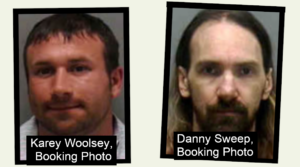
On that date, the courtroom was packed with members of Karey’s family. However, they were there to support both the defendants. Danny’s attorney, David Brener, did what he could for his client. “These people,” he told U.S. District Judge John Steele, pointing to the Woolsey clan, “became Mr. Sweep’s family. He and [Karey] Woolsey were very close.” So close in fact, “they actually called each other brothers.” That was part of the problem, Danny’s refusal to turn on Karey. No one knew how the judge would handle the “loyalty among thieves.”
Danny was sentenced to eleven years and eleven months to be served in the Federal Bureau of Prisons.
Minutes after the court pronounced judgment on Danny, Karey stepped into court for his sentencing. While laying out the extent of Karey’s drug trafficking organization the U.S. prosecutor characterized him as “incredibly business savvy.” He described the sophistication of his laundering operation. “Daniel Sweep was sort of the party side, [but] Mr. Woolsey was clearly the business side of the equation. He was far more focused on—on trying to make money.” The prosecutor detailed the ever increasing amounts of marijuana being bought, sold and distributed. “When looking at the organization, Mr. Woolsey was the kingpin…”
Karey tells me he was distraught during his sentencing. He’d been dating Misty for over a year and she had agreed to stick with him for six years of his incarceration. Upon release they would get married and have kids. Unfortunately, in order for Karey to be released from prison within six years he had to receive less than an eight-year sentence.
“She was sitting in the courtroom,” recalls Karey, “when the judge said, ‘One hundred and fifty-one months of incarceration.’ I remember looking back at her—tears pouring out of her eyes—and she mouthed, ‘I’m sorry, I can’t.’ Crazy, right? That that’s what I remember most about that day.”
AFTER A PROLONGED GUN BATTLE with the Mexican military in Tijuana, acting on DEA information, Eduardo Arellano-Felix was captured on October 25, 2008. The arrest of Eduardo closed the book on the Arellano-Felix band of brothers; the Tijuana plaza had finally fallen under the complete control of the Sinaloa Cartel.
VICENTE ZAMBADA checked into the Four Seasons Hotel in downtown Mexico City on March 17, 2009. His appointment with the Americans had been arranged days earlier by Loya, who was still acting as the Sinaloa Cartel’s in-house counsel.
Agent Castanon had tried to cancel due to a news article regarding the cartel member’s possible presence in the city, but Vicente refused. His father and Chapo had information for the agents. Someone they wanted removed.
The longer he stayed in the city the more dangerous the situation—Vicente was, after all, wanted by both the U.S. and Mexican law enforcement.
Hours later, Vicente attended the meeting with the Americans at the Sheraton Hotel—located directly across the street from the U.S. Embassy. With Loya present, he provided Agent Castanon and the other DEA Agents present with information regarding rival cartel activity and the location of a high-ranking rival cartel member.
Early the next morning, after Vicente had returned to his suite—based on a tip—the Mexican military raided the Four Seasons Hotel and arrested Mayo’s son. Despite the fact he had an agreement with the United States government, the Americans double-crossed Vicente, indicted him, and demanded his extradition.
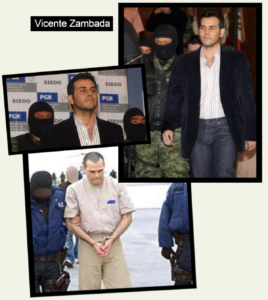
While he sat in prison waiting to be transported across the border, the acting commander of the Beltran-Leyva Cartel, Arturo Beltran-Leyva, was killed by the Mexican marines during a raid at his residence on December 16, 2009. The remaining Beltran-Leyva brothers blamed Mayo and Chapo for providing the authorities with the information utilized to ambush Arturo, resulting in an ever escalating series of retaliatory acts. The following year, on July 29, 2010, the last of the core Sinaloa Federation leaders, Nacho Coronel, the head of the Jalisco faction went out in a blaze of glory during the Mexican military’s attempt to arrest him.
Despite his agreement with the U.S. government, Vicente was extradited to Chicago. Once in the United States, the Americans denied they had a quid pro quo agreement with Vicente or any other leader of the Sinaloa Cartel. Unlike Loya, Vicente had nothing in writing.
Months later, however, the entire affair was on the verge of disclosure when the federal judge in Vicente’s case ordered the government to produce all material concerning the nature of its relationship with the Sinaloa Cartel. Suddenly, the U.S. Attorney’s Office in Chicago invoked the “Classified Information Procedures Act,” classifying all material related to the case, including the cartel’s agreement with the U.S. government. The government even invoked “national security” concerns to prevent Loya from being summoned as a witness by Vicente’s defense lawyers. Rather than run the risk of disclosing their arrangement to public scrutiny, the U.S. Attorney made Vicente an offer he couldn’t refuse.
On April 3, 2013, Vicente pled guilty to conspiracy to smuggle hundreds of tons of marijuana, cocaine and heroin into the United States—what should’ve been a mandatory life sentence—in exchange for a ten-year prison sentence. With time served and time off for “good behavior,” he should be released sometime in 2018. As a result of Zambada’s plea deal, any chance of the full extent of the U.S. government’s complicity with the Sinaloa Cartel’s leadership ever becoming public, via a trial, were deep sixed.
As for his father, however, six separate indictments across the United States have been returned charging Mayo and Chapo with overseeing a massive international drug conspiracy. At least three of those indictments charge German “G” Olivares with drug related charges and murder in the furtherance of drug trafficking. 4 The Tijuana plaza remains under Mayo’s and G’s control, although the warehouses Danny visited are no longer being utilized after the Mexican military raided the complex and seized over 100 tons of marijuana.
4 The most shocking allegations concerned the murder of an American citizen and two members of his family. According to the authorities, G ordered a group of Mayo’s gunmen to storm a wedding in El Paso to kidnap the groom, his brother and their uncle during the ceremony. The men had been abducted to answer for the loss of 670 pounds of marijuana seized by the border Patrol. Days later, their mutilated bodies were discovered by Juarez police in the bed of an abandoned pick-up truck.
Unlike Mayo and G, Chapo got cocky. Despite knowing the U.S. government was no longer protecting him and Mayo, he ventured out of his safe haven in the Sierra Madre mountains. Chapo was arrested by the Mexican military in a hotel while visiting with his former beauty queen wife. He subsequently escaped from prison on July 11, 2015, through a tunnel nearly a mile long, but was re-captured following a shootout with the Mexican marines on January 8, 2016. Chapo has been extradited to the United States where he is currently awaiting trial.
Juan Medina Gonzalez is still a fugitive, on the run somewhere in Mexico.
AT DANNY’S SENTENCING, the drug smuggler apologized to the court and admitted he would have done things differently given another chance. In all honesty, he feels the government allowed tons of marijuana to be imported into the country. Drugs that he and Karey were sentenced for. But no one in the U.S. government was ever prosecuted, however, Danny had to go to prison for nearly a dozen years for the same thing the government let the cartel do—on a massive scale. Both he and Karey received more time than Vicente Zambada.
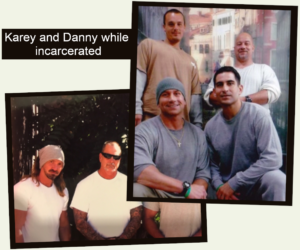
“Bro!” gasped Karey, when I laid out what can best be described as the U.S. government’s collusion with the Sinaloa Cartel. Their agreement helped fuel a drug war that cost the lives of tens of thousands of Mexican citizens and law enforcement officers on both sides of the border, and flooded the United States, among other countries, with incalculable tons of illegal drugs.
“The weed you and Danny were selling was purchased through the Sinaloa Federation,” I informed him. “Every single bud.” In a very real sense, the U.S. helped to create the Federation; the largest, most powerful drug trafficking organization the world has ever seen; by all appearances, the American government had endorsed the importation of the marijuana that Karey and Danny were distributing.
“That’s crazy, bro,” says Karey. He shakes his head and lets out a long, harsh sigh, “I’m not even a big pot smoker.”
Despite being wanted by both the American and Mexican governments, Mayo Zambada has never spent so much as one night in jail during his fifty year career as a drug trafficker. But he’s now in his seventies and he knows his time is running out. The president of Mexico recently turned down an offer by Mayo to retire in exchange for an agreement of non-prosecution.
His enemies are coming for him; it’s a problem.